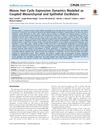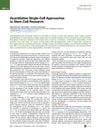Search
forLearn
1 / 1 resultsResearch
5 / 1000+ results
research Mouse Hair Cycle Expression Dynamics Modeled as Coupled Mesenchymal and Epithelial Oscillators
The study concluded that hair growth in mice is regulated by a stable interaction between skin cell types, and disrupting this can cause hair loss.

research Quantitative Single-Cell Approaches to Stem Cell Research
New single-cell analysis techniques are improving our understanding of stem cells and could help in treating diseases.
research Autophagy Protects Murine Preputial Glands Against Premature Aging and Controls Their Sebum Phospholipid and Pheromone Profile
Autophagy prevents early aging and maintains lipid and pheromone balance in mouse glands.
research The Role of Translation in Keratinocyte Cell Fate Determination
Translation levels actively determine keratinocyte cell fate.

research Hair Shaft Miniaturization Causes Stem Cell Depletion Through Mechanosensory Signals Mediated by a Piezo1-Calcium-TNF-α Axis
Hair thinning causes stem cell loss through a process involving Piezo1, calcium, and TNF-α.
Community Join
5 / 38 resultscommunity How do we only have two treatments to combat hair loss at this point in time?
The post discusses frustration over the limited and not always effective treatments for hair loss, mainly Minoxidil and Finasteride. The conversation includes mentions of potential new treatments like GT20029, HMI-115, CosmeRNA, KX-826, and microneedling, but also highlights the challenges of funding and prioritizing research in this area.
community MicroRNA can regrow 90% of lost hair, researchers find
Researchers finding that microRNA can potentially regrow 90% of lost hair, and the challenges involved in moving this research forward to human trials. Various treatments for hair loss, such as finasteride and minoxidil, have been discussed.
community Why is dht bad for scalp hair but good for hair on the rest of body?
The conversation discusses why DHT (dihydrotestosterone) negatively affects scalp hair but promotes growth elsewhere on the body. Various opinions include genetic predispositions, differences in hair follicle reactions to DHT, and the potential role of Omega-3 in reducing inflammation and promoting hair health.
community Journey against alopecia - Finasteride 3 month
A 26-year-old man from France started experiencing hair loss in September 2020 and began using finasteride in June 2021, reporting some improvement after three months without side effects. He plans to continue finasteride for a year before considering additional treatments like minoxidil or dermarolling.
community My Theory Of Androgenic Alopecia
Hair loss is linked to cellular physiology and the IGF-1 to TGF-B1 ratio, not just androgen sensitivity. The theory lacks evidence, while finasteride and minoxidil are effective treatments.